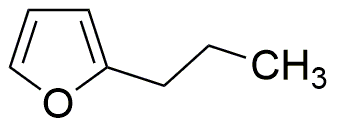2-Propylfuran is widely utilized in research focused on:
- Flavor and Fragrance Industry: This compound is used as a flavoring agent in food products and beverages, providing a sweet, nutty aroma that enhances sensory appeal.
- Solvent Applications: Due to its favorable solvent properties, 2-Propylfuran is employed in various chemical reactions and extractions, making it valuable in organic synthesis and pharmaceutical development.
- Fuel Additives: It is explored as a potential biofuel additive, improving the combustion properties of fuels and contributing to cleaner energy solutions.
- Polymer Production: The compound serves as a building block in the synthesis of polymers, offering enhanced thermal stability and mechanical properties compared to similar compounds.
- Research in Green Chemistry: Its role in sustainable chemical processes is being studied, promoting eco-friendly practices in industrial applications and reducing environmental impact.
General Information
Properties
Safety and Regulations
Applications
2-Propylfuran is widely utilized in research focused on:
- Flavor and Fragrance Industry: This compound is used as a flavoring agent in food products and beverages, providing a sweet, nutty aroma that enhances sensory appeal.
- Solvent Applications: Due to its favorable solvent properties, 2-Propylfuran is employed in various chemical reactions and extractions, making it valuable in organic synthesis and pharmaceutical development.
- Fuel Additives: It is explored as a potential biofuel additive, improving the combustion properties of fuels and contributing to cleaner energy solutions.
- Polymer Production: The compound serves as a building block in the synthesis of polymers, offering enhanced thermal stability and mechanical properties compared to similar compounds.
- Research in Green Chemistry: Its role in sustainable chemical processes is being studied, promoting eco-friendly practices in industrial applications and reducing environmental impact.
Documents
Safety Data Sheets (SDS)
The SDS provides comprehensive safety information on handling, storage, and disposal of the product.
Product Specification (PS)
The PS provides a comprehensive breakdown of the product’s properties, including chemical composition, physical state, purity, and storage requirements. It also details acceptable quality ranges and the product's intended applications.
Certificates of Analysis (COA)
Search for Certificates of Analysis (COA) by entering the products Lot Number. Lot and Batch Numbers can be found on a product’s label following the words ‘Lot’ or ‘Batch’.
*Catalog Number
*Lot Number
Certificates Of Origin (COO)
This COO confirms the country where the product was manufactured, and also details the materials and components used in it and whether it is derived from natural, synthetic, or other specific sources. This certificate may be required for customs, trade, and regulatory compliance.
*Catalog Number
*Lot Number
Safety Data Sheets (SDS)
The SDS provides comprehensive safety information on handling, storage, and disposal of the product.
DownloadProduct Specification (PS)
The PS provides a comprehensive breakdown of the product’s properties, including chemical composition, physical state, purity, and storage requirements. It also details acceptable quality ranges and the product's intended applications.
DownloadCertificates of Analysis (COA)
Search for Certificates of Analysis (COA) by entering the products Lot Number. Lot and Batch Numbers can be found on a product’s label following the words ‘Lot’ or ‘Batch’.
*Catalog Number
*Lot Number
Certificates Of Origin (COO)
This COO confirms the country where the product was manufactured, and also details the materials and components used in it and whether it is derived from natural, synthetic, or other specific sources. This certificate may be required for customs, trade, and regulatory compliance.

